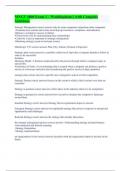, CHAPTER 1
Introducing Health Psychology
Lecture Outline
I. The Changing Field of Health
During the 20th century, changes in the field of health were accompanied by changing
patterns of disease. In 1900, most diseases were short-duration, infectious diseases, but by the
end of the century, behavior and lifestyle were the underlying causes of most diseases. These
changes have influenced the cost of medical care and even the definition of health, which point
to the possibility that a biopsychosocial approach may provide a better model than the
biomedical model.
A. Patterns of Disease and Death
In recent years chronic diseases have become the leading causes of death in the United
States and many other countries around the world, especially industrialized ones. In 1900,
three of the leading causes of death were pneumonia, influenza, and tuberculosis, while in
2009 three of the leading causes of death were heart disease, cancer, and stroke. These three
causes of death account for about 60% of deaths in the United States. These causes of death
have declined in recent years. Unintentional injuries and other diseases that primarily affect
young and middle-aged people have increased in recent years. Diseases that affect older
people, such as Alzheimer's disease and Parkinson’s disease, are increasing as the U.S.
population ages.
1. Age
Age is an important factor in mortality. Cardiovascular disease and cancer account
for a large percentage of death in the US, but they are not the leading cause of death for
younger adults. For younger adults, the leading cause of death is unintentional injuries,
and violent deaths, such as suicide or homicide.
2. Ethnicity, Income, and Disease
The United States ranks 24th among industrialized nations in life expectancy,
indicating that many countries are healthier. In addition, ethnicity is a factor in life
expectancy, but economic status and educational level are both related to ethnic
background. African Americans have higher rates of health problems than European
Americans. Hispanic Americans also experience poverty, low educational levels, and
negative effects to health.
3. Changes in Life Expectancy
Life expectancy has grown from 47.3 years in 1900 to over 77 years today. Behavior
has also been a factor in the decline in deaths due to cardiovascular disease, but the major
gains in life expectancy during the 20th century were due to decreases in infant mortality.
Prevention of disease—such as vaccinations and safer drinking water--is also a
contributor to the increase in life expectancy.
B. Escalating Cost of Medical Care
In the United States, costs of medical care have escalated far beyond the inflation rate.
Between 1975 and 2005, medical costs rose over 600%, and during the early years of the
21st century, over 15% of the gross domestic product was spent for health care. This
escalating cost has led some people to question the cost effectiveness of cures and to
emphasize the role of prevention as a way to contain medical costs.
C. What is Health?
,Chapter 1
The traditional view of health is the absence of disease, a definition that follows the
biomedical model of diseases produced by pathogens. The biopsychosocial model offers
an alternative view, adding psychological and social factors to biological factors. Theorists
who advocate this model study the interactions among biological, psychological, and social
factors in health and disease. This definition allows a definition of health as the attainment of
a positive state, and not merely the absence of disease.
The definition of health as attainment of a positive state of wellness is compatible with
the World Health Organization’s definition and also with the view proposed by positive
psychology. This movement within psychology includes health issues, such as the influence
of optimism on health and health-related behaviors.
II. Psychology's Relevance for Health
Health psychologists concentrate on the behavioral and lifestyle components in the
development of chronic diseases, but they also attempt to help people cope with stress, pain, and
chronic disease.
A. The Contribution of Psychosomatic Medicine
Psychosomatic medicine is based on the premise that physical illness has its roots in
psychological and emotional conflicts. This view emphasized the connection between
emotion and disease, which is a positive contribution, but the negative aspect of
psychosomatic medicine was the belief that disease has no real basis and is “all in the
person’s head.”
B. The Emergence of Behavioral Medicine
The development of behavioral medicine altered psychology’s role in medicine by
concentrating on behavioral rather than mental factors in health and illness. Behavioral
medicine is an interdisciplinary field that attempts to integrate behavioral and biomedical
knowledge and techniques and to apply this knowledge to prevention, diagnosis, treatment,
and rehabilitation.
C. The Emergence of Health Psychology
Health psychology is a field of psychology dealing with the scientific study of behaviors
that relate to health enhancement, disease prevention, and rehabilitation. This relatively
new discipline developed as a result of an APA taskforce that found a scarcity of health-
related research by psychologists. In 1976, psychologists interested in and working in
health-related settings formed Division 38 (Health Psychology) of the American
Psychological Association.
III. The Profession of Health Psychology
Psychologists in general and health psychologists in particular have the training to
contribute to the nation's good health. It has founded its own national and international
associations, established a number of its own journals, gained recognition in other fields of
health care, established graduate training programs, and has received recognition from the
American Board of Professional Psychology and other professional groups. In addition, its
historical involvement in changing human behavior places it in a position to help people
eliminate unhealthy practices as well as to incorporate healthy behaviors into an ongoing
lifestyle.
A. The Training of Health Psychologists
Health psychologists receive a solid core of generic training at the doctoral level in the
basic areas of psychology plus training in biological and medical specialty areas that
2
, Introducing Health Psychology
prepares them to work as part of interdisciplinary teams and possibly to become primary
health care providers.
B. The Work of Health Psychologists
Health psychologists have jobs that are similar to those of other psychologists—they
teach, provide assessments, conduct research, and provide services. Those who are employed
by a university typically teach and do research, and those who work in a clinical setting are
usually involved in assessment, diagnosis, and therapy. Health psychologists may also be
employed in medical schools where their duties include working with other health care
professionals in providing services for people with physical disorders or in clinics, HMOS,
or private practice providing services such as pain management, smoking cessation, stress
management, or other such applications.
Exploring Health on the Web
The Internet is a source for health information on all levels, from press releases to technical
research. Problems arise in selecting valid information from the many sources available.
Exploring Health on the Web offers information on selected Internet sites that provide credible
health information.
http://healthfinder.gov
One of the main websites for obtaining health-related information and for finding links to
other sites is healthfinder®. The U.S. Department of Health and Human Services maintains this
gateway website, and it is an excellent place to access information and to link to other sites
devoted to health information. This website is oriented toward consumers and includes a
homepage with a variety of choices that will help patients use the Internet to obtain information
and to find links to other sites. The site also provides options that allow users to gain access to
the technical health information collected by various government agencies.
http://www.nlm.nih.gov/medlineplus
MedlinePlus is a website that makes information available from the National Library of
Medicine. It includes information from the National Institutes of Health and other government
sources as well as information on hospitals and physicians, prescription and nonprescription
drugs, and a great deal more. MedlinePlus can be a basic resource for obtaining health
information because this website contains no advertising, is screened for quality of information,
and is updated daily.
One feature on MedlinePlus is “A Guide to Healthy Web Surfing” (accessible at
http://www.nlm.nih.gov/medlineplus/healthywebsurfing.html ), which presents a series of
warnings to those who seek health information on the Internet. The Internet offers a vast amount
of information but little screening for quality or truth. The information in this website can help
students think critically about material they get from the Net.
http://www.health-psych.org/
This website is home for APA’s Division 38 and contains a section entitled “What is a
Health Psychologist?” and “Frequently Asked Questions about Training in Health Psychology.”
This site can be a good resource for students who are interested in training and career
opportunities in the field of health psychology.
http://www.sbm.org/
3





